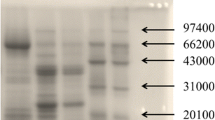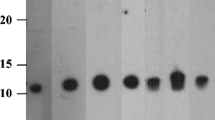Abstract
“Hidden” peanut allergens in commercial foods pose a potential risk for peanut-allergic individuals. Sensitive and reliable analytical methods are urgently needed for detecting peanut in processed foods at low levels. We developed a peanut sandwich ELISA test kit by pairing two polyclonal sera against peanut proteins obtained from different spices. Its analytical performance of sensitivity, specificity, accuracy, trueness, and precision were evaluated, respectively. The limit of detection (LOD) was defined as 0.001 mg/kg, and no cross-reactivity was observed in 25 spices including legumes, tree nuts, and seeds. Besides, the mean recoveries in four spiked food matrixes ranged from 74.067 to 122.953%, and the recoveries of the three model foods incurred with peanut proteins were within the range of 80–120%. Acceptable results of repeatability and reproducibility were obtained referring to the AOAC standard. Moreover, it was verified to be capable of applying for detecting peanut residues in commercially available food products in the market and evaluating the food labels effectively. The study provides powerful technical support for the sensitive detection of peanut products for both food manufacturers and regulatory agencies.




Similar content being viewed by others
References
Shah F, Shi A, Ashley J, Kronfel C, Wang Q, Maleki SJ, Adhikari B, Zhang J (2019) Peanut allergy: characteristics and approaches for mitigation. Compr Rev Food Sci F 18(5):1361–1387
Gray CL (2020) Current controversies and future prospects for peanut allergy prevention, diagnosis and therapies. J Asthma Allergy 13:51–66
Sicherer SH, Sampson HA (2018) Food allergy: a review and update on epidemiology, pathogenesis, diagnosis, prevention, and management. J Allergy Clin Immun 141(1):41–58
Flinn A, Hourihane JO (2013) Allergic reaction to peanuts: can we predict reaction severity in the wild? Curr Allergy Asthm R 13(6):645–650
Bock SA, Munoz-Furlong A, Sampson HA (2007) Further fatalities caused by anaphylactic reactions to food, 2001–2006. J Allergy Clin Immun 119(4):1016–1018
Savage J, Sicherer S, Wood R (2016) The natural history of food allergy. J Aller Cl Imm-Pract 4(2):196–203
Sena-Torralba A, Pallás-Tamarit Y, Morais S, Maquieira Á (2020) Recent advances and challenges in food-borne allergen detection. Trac-Trend Anal Chem 132:116050
Allen KJ, Turner PJ, Pawankar R, Taylor S, Sicherer S, Lack G, Rosario N, Ebisawa M, Wong G, Mills ENC (2014) Precautionary labelling of foods for allergen content: are we ready for a global framework? World Allergy Organ 7:10
Venter C, Sicherer SH, Greenhawt M (2019) Management of peanut allergy. J Aller Cl Imm-Pract 7(2):345-355.e2
Campuzano S, Montiel VR, Serafin V, Yanez-Sedeno P, Pingarron JM (2020) Cutting-edge advances in electrochemical affinity biosensing at different molecular level of emerging food allergens and adulterants. Biosensors-Basel 10(2):10
Prado M, Ortea I, Vial S, Rivas J, Calo-Mata P, Barros-Velazquez J (2016) Advanced DNA- and protein-based methods for the detection and investigation of food allergens. Crit Rev Food Sci 56(15):2511–2542
Holzhauser T, Johnson P, Hindley JP, O’Connor G, Chan CH, Costa J, Faeste CK, Hirst BJ, Lambertini F, Miani M, Robert MC, Roder M, Ronsmans S, Bugyi Z, Tomoskozi S, Flanagan SD (2020) Are current analytical methods suitable to verify VITAL(R) 2.0/3.0 allergen reference doses for EU allergens in foods? Food Chem Toxicol 145:111709
Wensing M, Penninks AH, Hefle SL, Koppelman SJ, Bruijnzeel-Koomen CA, Knulst AC (2002) The distribution of individual threshold doses eliciting allergic reactions in a population with peanut allergy. J Allergy Clin Immun 110(6):915–920
Allen KJ, Remington BC, Baumert JL, Crevel RW, Houben GF, Brooke-Taylor S, Kruizinga AG, Taylor SL (2014) Allergen reference doses for precautionary labeling (VITAL 20): clinical implications. J Allergy Clin Immun 133(1):156–164
Pomes A, Vinton R, Chapman MD (2003) Peanut allergen (Ara h 1) detection in foods containing chocolate. J Allergy Clin Immun 111(2):S194–S194
Vandekerckhove M, Droogenbroeck BV, Loose MD, Taverniers I, Daeseleire E, Gevaert P, Lapeere H, Poucke CV (2017) Development of an LC-MS/MS method for the detection of traces of peanut allergens in chili pepper. Anal Bioanal Chem 409(22):5201–5207
Marsh JT, Jayasena S, Gaskin F, Baumert JL, Johnson P (2020) Thermal processing of peanut impacts detection by current analytical techniques. Food Chem 313:126019
Hefle SL, Jeanniton E, Taylor SL (2001) Development of a sandwich enzyme-linked immunosorbent assay for the detection of egg residues in processed foods. J Food Protect 64(11):1812–1816
Laemmli UK (1970) Cleavage of structural proteins during the assembly of the head of bacteriophage T4. Nature 227:680–685
Abbott M, Hayward S, Ross W, Godefroy SB, Delahaut P (2010) Validation procedures for quantitative food allergen elisa methods: community guidance and best practices. J AOAC Int 93(2):442–450
Magnusson B, Örnemark U (2014) Eurachem Guide: The Fitness for Purpose of Analytical Methods—A Laboratory Guide to Method Validation and Related Topics. 2nd ed. ISBN 978-91-87461-59-0. http://www.eurachem.org
Sicherer SH, Sampson HA (2000) Peanut and tree nut allergy. Curr Opin Pediatr 12(6):567–573
Mennini M, Dahdah L, Mazzina O, Fiocchi A (2016) Lupin and other potentially cross-reactive allergens in peanut allergy. Curr Allergy Asthm R 16(12):84
Morishita N, Kamiya K, Matsumoto T (2008) Reliable enzyme-linked immunosorbent assay for the determination of soybean proteins in processed foods. J Agr Food Chem 56(16):6818–6824
Guidelines for standard method performance requirements. Appendix F, 16
Stephan O, Vieths S (2004) Development of a real-time PCR and a sandwich ELISA for detection of potentially allergenic trace amounts of peanut (Arachis hypogaea) in processed foods. J Agr Food Chem 52(12):3754–3760
Hefle SL, Bush RK, Yunginger JW, Chu FS (1994) A sandwich enzyme-linked immunosorbent assay (ELISA) for the quantitation of selected peanut proteins in foods. J Food Protect 57(5):419–423
Jayasena S, Smits M, Fiechter D, Jong AD, Nordlee J, Baumert J, Taylor SL, Pieters RH, Koppelman SJ (2015) Comparison of six commercial ELISA kits for their specificity and sensitivity in detecting different major peanut allergens. J Agr Food Chem 63(6):1849–1855
Khuda S, Slate A, Pereira M, Al-Taher F, Jackson L, Diaz-Amigo C, Bigley EC 3rd, Whitaker T, Williams KM (2012) Effect of processing on recovery and variability associated with immunochemical analytical methods for multiple allergens in a single matrix: sugar cookies. J Agr Food Chem 60(17):4195–4203
Pele M, Brohee M, Anklam E, Van Hengel AJ (2007) Peanut and hazelnut traces in cookies and chocolates: relationship between analytical results and declaration of food allergens on product labels. Food Addit Contam 24(12):1334–1344
Acknowledgements
This study was funded by the National Natural Science Foundation of China (No. 32072338).
Author information
Authors and Affiliations
Corresponding author
Ethics declarations
Conflict of interest
The authors declare that they have no conflicts of interest.
Compliance with ethics requirements
All applicable international, national, and/or institutional guidelines for the care and use of animals were followed. This article does not contain any studies with human participants performed by any of the authors.
Additional information
Publisher's Note
Springer Nature remains neutral with regard to jurisdictional claims in published maps and institutional affiliations.
Rights and permissions
About this article
Cite this article
Ji, Y., Lin, H., Zhao, J. et al. Development of a sensitive sandwich enzyme-linked immunosorbent assay test kit for reliable detection of peanut residues in processed food. Eur Food Res Technol 248, 273–282 (2022). https://doi.org/10.1007/s00217-021-03879-8
Received:
Accepted:
Published:
Issue Date:
DOI: https://doi.org/10.1007/s00217-021-03879-8




